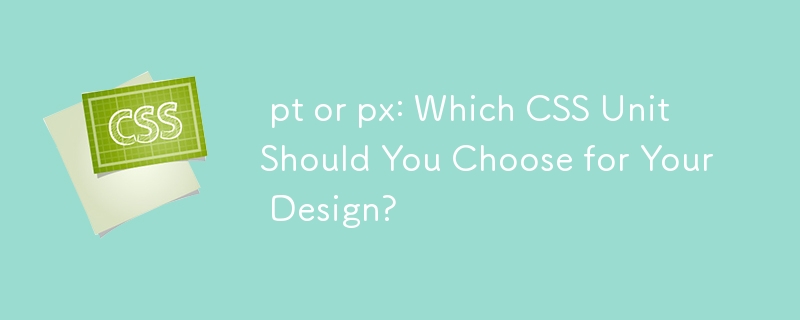pt or px: Which CSS Unit Should You Choose for Your Design?

Understanding the Difference Between pt and px in CSS
When defining elements using CSS, the choice between pt and px can significantly impact the appearance and behavior of your design. Understanding the difference between these units is crucial for achieving optimal results.
pt (Points)
Points are a unit of measurement based on typography. One point is equivalent to 1/72 of an inch. This unit is commonly used in print design and is especially valuable for specifying font sizes and line spacing. By using points, designers ensure consistent text measurements across different devices, regardless of the screen resolution or pixel density.
px (Pixels)
Pixels are absolute units that represent the physical pixels on a display. One pixel is the smallest unit of measurement on a screen. Using px allows designers to precisely control the size and position of elements, ensuring they appear the same on all devices with the same resolution.
Which One to Use?
The choice between pt and px depends on the specific requirements of your design.
- Use pt for elements that require consistency across devices: This includes text elements, such as font sizes, line spacing, and margins, as well as line breaks and indents. Using pt ensures that these elements will maintain their intended proportions and readability, regardless of the device's resolution or screen size.
- Use px for elements that need precise placement or size control: This applies to graphical elements, such as images, icons, and buttons, as well as element positioning and spacing. Using px allows you to specify exact pixel values, ensuring precise control over the appearance and placement of these elements.
Additional Considerations
- Browser compatibility: Both pt and px units are supported by all major browsers. However, some older browsers may have limitations in rendering pt units accurately.
- Device independence: px units are device-independent, meaning they maintain the same physical size on all devices with the same resolution. pt units, on the other hand, can vary in size depending on the device's resolution and screen size.
- Print output: pt units are traditionally used for print design, while px units are more suitable for digital displays. When designing for print, it's important to use pt units to ensure consistent and accurate measurements.
The above is the detailed content of pt or px: Which CSS Unit Should You Choose for Your Design?. For more information, please follow other related articles on the PHP Chinese website!

Hot AI Tools

Undresser.AI Undress
AI-powered app for creating realistic nude photos

AI Clothes Remover
Online AI tool for removing clothes from photos.

Undress AI Tool
Undress images for free

Clothoff.io
AI clothes remover

Video Face Swap
Swap faces in any video effortlessly with our completely free AI face swap tool!

Hot Article

Hot Tools

Notepad++7.3.1
Easy-to-use and free code editor

SublimeText3 Chinese version
Chinese version, very easy to use

Zend Studio 13.0.1
Powerful PHP integrated development environment

Dreamweaver CS6
Visual web development tools

SublimeText3 Mac version
God-level code editing software (SublimeText3)

Hot Topics
 1664
1664
 14
14
 1421
1421
 52
52
 1315
1315
 25
25
 1266
1266
 29
29
 1239
1239
 24
24
 Google Fonts Variable Fonts
Apr 09, 2025 am 10:42 AM
Google Fonts Variable Fonts
Apr 09, 2025 am 10:42 AM
I see Google Fonts rolled out a new design (Tweet). Compared to the last big redesign, this feels much more iterative. I can barely tell the difference
 How to Create an Animated Countdown Timer With HTML, CSS and JavaScript
Apr 11, 2025 am 11:29 AM
How to Create an Animated Countdown Timer With HTML, CSS and JavaScript
Apr 11, 2025 am 11:29 AM
Have you ever needed a countdown timer on a project? For something like that, it might be natural to reach for a plugin, but it’s actually a lot more
 HTML Data Attributes Guide
Apr 11, 2025 am 11:50 AM
HTML Data Attributes Guide
Apr 11, 2025 am 11:50 AM
Everything you ever wanted to know about data attributes in HTML, CSS, and JavaScript.
 A Proof of Concept for Making Sass Faster
Apr 16, 2025 am 10:38 AM
A Proof of Concept for Making Sass Faster
Apr 16, 2025 am 10:38 AM
At the start of a new project, Sass compilation happens in the blink of an eye. This feels great, especially when it’s paired with Browsersync, which reloads
 How We Created a Static Site That Generates Tartan Patterns in SVG
Apr 09, 2025 am 11:29 AM
How We Created a Static Site That Generates Tartan Patterns in SVG
Apr 09, 2025 am 11:29 AM
Tartan is a patterned cloth that’s typically associated with Scotland, particularly their fashionable kilts. On tartanify.com, we gathered over 5,000 tartan
 How to Build Vue Components in a WordPress Theme
Apr 11, 2025 am 11:03 AM
How to Build Vue Components in a WordPress Theme
Apr 11, 2025 am 11:03 AM
The inline-template directive allows us to build rich Vue components as a progressive enhancement over existing WordPress markup.
 PHP is A-OK for Templating
Apr 11, 2025 am 11:04 AM
PHP is A-OK for Templating
Apr 11, 2025 am 11:04 AM
PHP templating often gets a bad rap for facilitating subpar code — but that doesn't have to be the case. Let’s look at how PHP projects can enforce a basic
 A Comparison of Static Form Providers
Apr 16, 2025 am 11:20 AM
A Comparison of Static Form Providers
Apr 16, 2025 am 11:20 AM
Let’s attempt to coin a term here: "Static Form Provider." You bring your HTML




